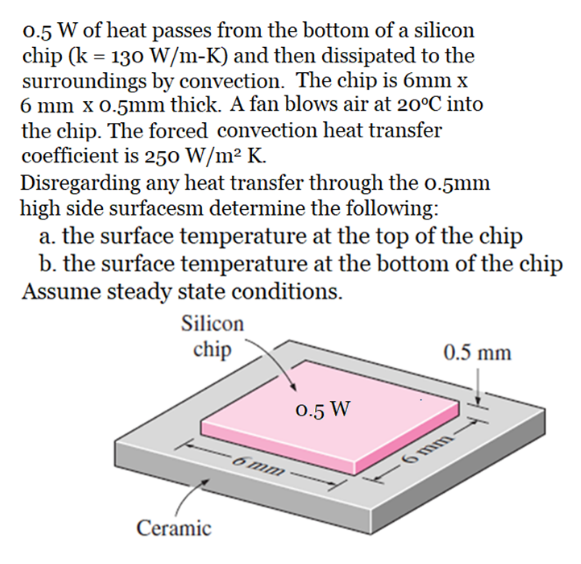0.5 W of heat passes from the bottom of a silicon chip (k = 130 W/m-K) and then dissipated to the surroundings by convection. The chip is 6mm x 6 mm x 0.5mm thick. A fan blows air at 20°C into the chip. The forced convection heat transfer coefficient is 250 W/m² K. Disregarding any heat transfer through the o.5mm high side surfacesm determine the following: a. the surface temperature at the top of the chip b. the surface temperature at the bottom of the chip Assume steady state conditions. Silicon chip 0.5 mm 0.5 W -6mm -6 mm Ceramic
0.5 W of heat passes from the bottom of a silicon chip (k = 130 W/m-K) and then dissipated to the surroundings by convection. The chip is 6mm x 6 mm x 0.5mm thick. A fan blows air at 20°C into the chip. The forced convection heat transfer coefficient is 250 W/m² K. Disregarding any heat transfer through the o.5mm high side surfacesm determine the following: a. the surface temperature at the top of the chip b. the surface temperature at the bottom of the chip Assume steady state conditions. Silicon chip 0.5 mm 0.5 W -6mm -6 mm Ceramic
Principles of Heat Transfer (Activate Learning with these NEW titles from Engineering!)
8th Edition
ISBN:9781305387102
Author:Kreith, Frank; Manglik, Raj M.
Publisher:Kreith, Frank; Manglik, Raj M.
Chapter6: Forced Convection Over Exterior Surfaces
Section: Chapter Questions
Problem 6.36P
Related questions
Question
I need handwritten or I'll dislike

Transcribed Image Text:0.5 W of heat passes from the bottom of a silicon
chip (k = 130 W/m-K) and then dissipated to the
surroundings by convection. The chip is 6mm x
6 mm x 0.5mm thick. A fan blows air at 20°C into
the chip. The forced convection heat transfer
coefficient is 250 W/m² K.
Disregarding any heat transfer through the o.5mm
high side surfacesm determine the following:
a. the surface temperature at the top of the chip
b. the surface temperature at the bottom of the chip
Assume steady state conditions.
Silicon
chip
0.5 mm
0.5 W
6 mm
-6mm
Ceramic
Expert Solution
This question has been solved!
Explore an expertly crafted, step-by-step solution for a thorough understanding of key concepts.
Step by step
Solved in 2 steps with 2 images

Knowledge Booster
Learn more about
Need a deep-dive on the concept behind this application? Look no further. Learn more about this topic, mechanical-engineering and related others by exploring similar questions and additional content below.Recommended textbooks for you

Principles of Heat Transfer (Activate Learning wi…
Mechanical Engineering
ISBN:
9781305387102
Author:
Kreith, Frank; Manglik, Raj M.
Publisher:
Cengage Learning

Principles of Heat Transfer (Activate Learning wi…
Mechanical Engineering
ISBN:
9781305387102
Author:
Kreith, Frank; Manglik, Raj M.
Publisher:
Cengage Learning